Eclipse on Next.js: Conditioned exploitation of an intended race-condition
Published in zhero_web_security, 2025
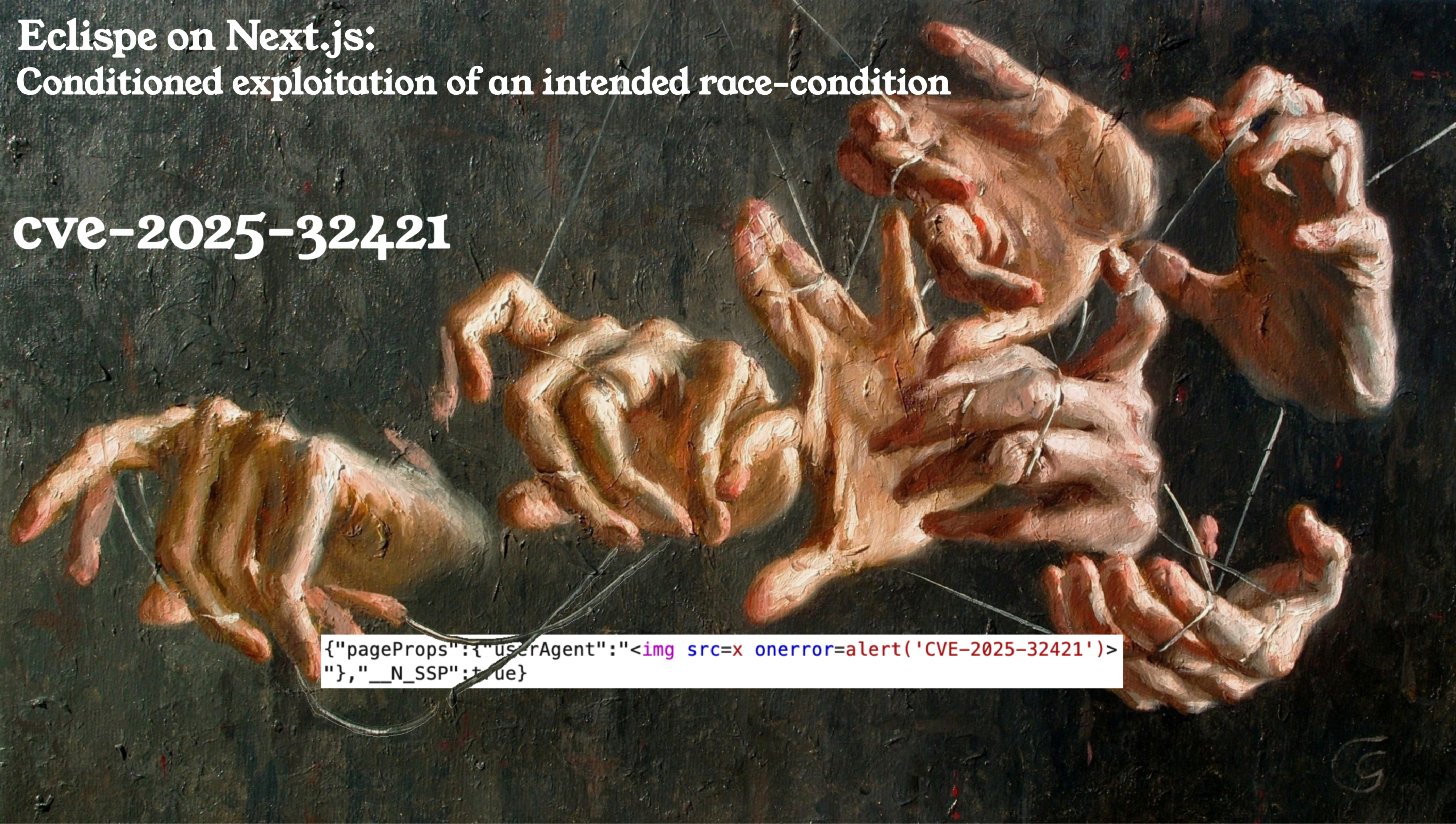
Introduction
Back to the Next.js framework this time, with a modest but rather interesting piece of research born out of a need to bypass the patch implemented following one of my previous vulnerabilities, CVE-2024-46982, still my favorite to date on Next. I strongly recommend reading the previous paper on the subject for a better understanding, namely “Next.js, cache, and chains: the stale elixir”. I won’t go into detail about the previous CVE, nor revisit some basic concepts already covered earlier (SSG, SSR..).
It all started some time ago, when I was looking for vulnerable targets (BBP) to the famous stale elixir. I came across an asset whose version was higher than that of the patch and exhibited strange behavior, prompting me to take another look at the source code, which led to the discovery of race condition, which - when chainable with a cache poisoning - allows bypassing the previous patch, potentially leading to an SXSS in the best/worst case scenario, depending on the point of view.
Its exploitability stems from misconfigurations/poor implementation practices that are for the most part outside the scope of Next.js’s responsibility, making the AC: H metric in the CVSS vector fully appropriate, as you’ll soon see. I still found it worthwhile to document, especially since there are a few real-world targets out there that remain exposed, enough to be of interest to some fellow hunters.
Index
- Mission objective: “Bypass” CVE-2024-46982
- Batcher and cache-key
- Race Condition - It’s eclipse time
- Bonus - Another way: never-say-never
- Security Advisory - CVE-2025-32421
- Conclusion
Mission objective: "Bypass" CVE-2024-46982
The fix for CVE-2024-46982 was implemented starting from version 14.2.10, after which the addition of the x-now-route-matches header no longer altered the Cache-Control. However, it was not stripped from the user request until version 15.1.6, and would trigger a 500 error when added to a request for an SSR endpoint.
Although the 500 page triggered by the header can be cached on misconfigured CDNs, as I’ve been able to observe on some sites, the impact is limited to the DoS aspect, since the page itself isn’t altered, unlike the previous CVE.
As a reminder, CVE-2024-46982 directly impacted the framework’s caching system, allowing cache poisoning, regardless of the presence of a CDN system, which made the vulnerability particularly dangerous and its scope relatively broad. The impact was ranged from a DoS attack via page alteration, replacing the entire page with a pageProps object, to a stored XSS if a request element was passed through getServerSideProps, due to the content-type being text/html after response poisoning. see more here
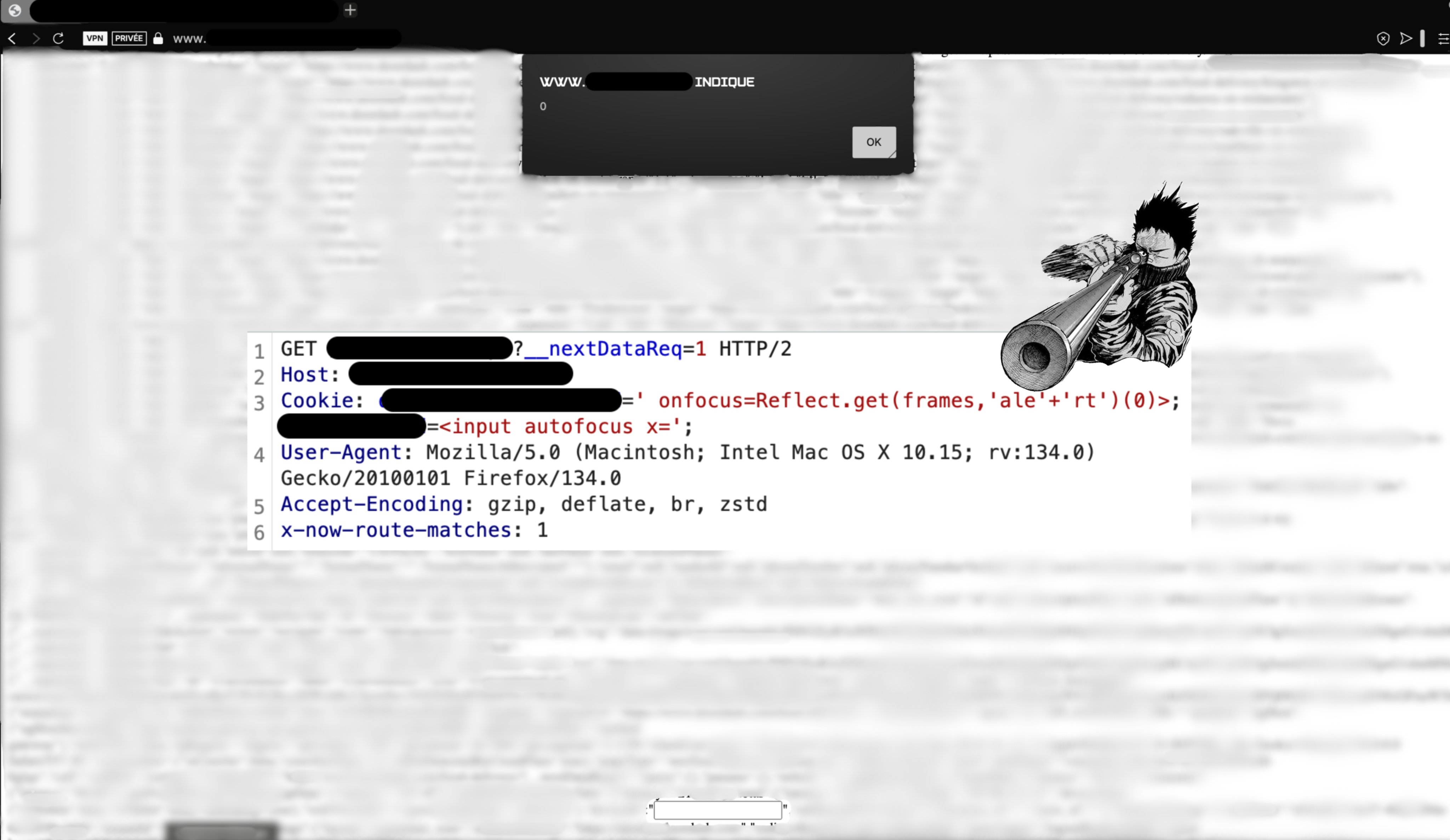 Cache-Poisoning to Stored-XSS on a BBP (CVE-2024-46982)
Cache-Poisoning to Stored-XSS on a BBP (CVE-2024-46982)
The goal is therefore to find a way to obtain a complete alteration of the page again by pageProps under a text/htmt content-type, for versions between 14.2.10 and 15.1.6 (the version from which the header is stripped). Keeping in mind that the exploit this time will not impact the framework cache but an external one, poorly configured, thus reducing its scope significantly due to its very conditioned nature.
All local tests performed in this paper were done on version 15.0.4, on the pages router (router affected by CVE-2024-46982).
Batcher and cache-key
It all starts here, a batcher used as a promise anti-duplication mechanism: when several calls with the same key are made before the previous one completes, the batcher executes the fn function only once and shares the result with all callers.
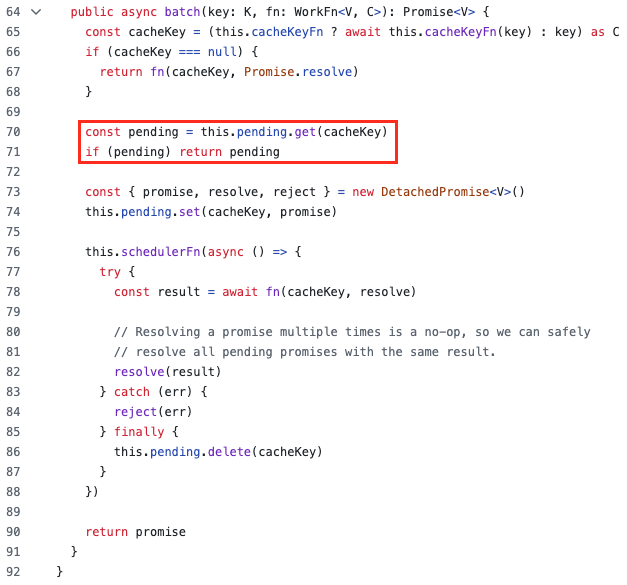 source: next.js/packages/next/src/lib/batcher.ts
source: next.js/packages/next/src/lib/batcher.ts
New promises are created and stored with their cacheKey in a Map object named pending. When a call arrives, a check is performed to see if a promise already exists for this key in the Map, if so, the existing promise is reused avoiding recreating a new promise for the same operation. It serves as an optimization process that avoids repeating costly operations for identical concurrent requests and is particularly used during cache revalidation and static page generation.
The cacheKey used by the batcher is defined in response-cache/index.ts. It consists of the requested path, followed by a dash and either 0 or 1, depending on whether it’s an on-demand revalidation request:
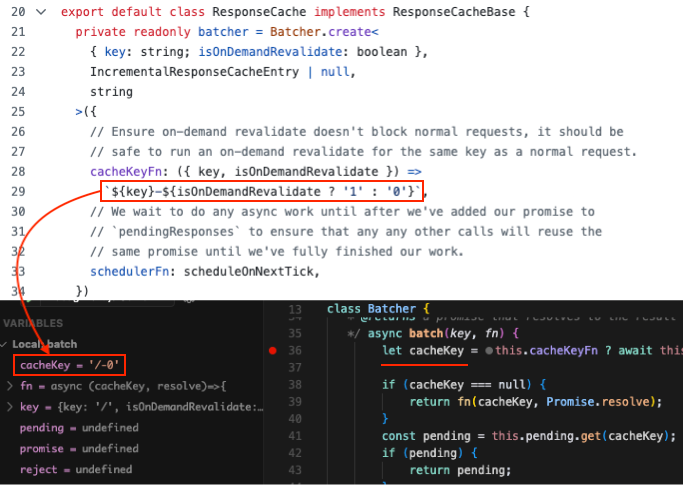 sources: /src/server/response-cache/index.ts and /src/lib/batcher.ts
sources: /src/server/response-cache/index.ts and /src/lib/batcher.ts
As you may have noticed, a simple request to the root page -/- (without on-demand revalidation) is assigned the following key : /-0. Note that URL parameters are therefore not taken into account in the cacheKey.
Let's dissect
Once the promise is created, the fn function is executed; a callback responsible for generating/retrieving the expected data, whose result is then used to resolve the promise shared among all calls with the same key, as previously explained. A classic SSR page will therefore not trigger this function, the latter being - by default - neither generated nor revalidated/cached.
However, we know that the x-now-route-matches header allows an SSR request to be passed as a static request (SSG). Since the fix, simply adding the header results in a 500 error in the form of an HTML page (without modifying the cache control):
 request containing the x-now-route-matches header to an SSR endpoint
request containing the x-now-route-matches header to an SSR endpoint
A little debugging reveals that when the header is added to our request to the SSR page: /poc, the fn function is triggered twice, with two different cacheKeys:
/poc-0-> page initially requested/_error-0-> error page was requested due to confusion caused by the header; although the SSR page may appear to be an SSG page because of the header, its nature remains unchanged, and it therefore lacks revalidation, which causes Next.js to throw an error in src/server/base-server.ts :
if (cacheEntry.revalidate < 1) {
throw new Error(`Invalid revalidate configuration provided: ${cacheEntry.revalidate} < 1`);
}
The initial exploit for CVE-2024-46982 combined the x-now-route-matches header for the SSG and the __nextDataReq URL parameter to make it a data request. Now (after the fix), by sending a request combining these two elements, we still get a 500 status code, but with a different body/content-type this time:

Another look at the debugger, the fn function is now called 3 times, with the same two cacheKeys as before:
/poc-0-> page initially requested/_error-0-> error page was requested due to confusion caused by the header, as seen earlier/_error-0-> a second error, this time caused by the addition of the__nextDataReqparameter which raised an error in stream handling within the pipe-readable.js file
The second error led to a fork in code execution, landing in a base-server.ts catch block, which resulted in the body being rewritten:

What’s interesting is that despite the error, the HTML prepared by the fn function for this call - the second error - was indeed the pageProps, it was just rewritten a little further down the execution pipeline. Check this with my super console.log (yea, long live console.log):

Let’s pause for a moment and list the ingredients:
- One request containing the HTML of the
/_errorpage in its body, with the actual cacheKey:/_error-0 - A second request containing the much-desired
pagePropsin its body, having been overwritten further down the execution pipeline with “InternalServerError”, also using the cacheKey:/_error-0 - A batcher acting as a promise anti-duplication mechanism based on the
cacheKey
Race Condition - It's eclipse time

By sending both requests simultaneously, we can hijack the promise anti-duplication mechanism to get the pageProps in a completely altered text/html response:
 pageProps rebirth!
pageProps rebirth!
This is possible because the calls generated by the first request - containing header + parameter - share the same cacheKey as those triggered by the second (/_error-0). The batcher will therefore only create promises for the initial calls, and any subsequent ones arriving during their execution window will not trigger new promises, they will simply receive the result of the initial requests once resolved.
Let’s ignore the calls using /poc-0 as a cacheKey; they’re not relevant in our case since an error is thrown later in the execution, preventing their results from being rendered. We therefore have two calls with /error-0 as a cacheKey generated by request 1 (header + parameter), and one call with /error-0 as a cacheKey generated by request 2 (header only).
Regardless of the result, the response from request 1 will remain unchanged, since -as we saw earlier- its body is rewritten later in the execution pipeline. However, the response from request 2 has two possible outcomes (when both requests are sent simultaneously):
- The display of
pagePropswithtext/htmlas a content-type, fulfilling the initial objective. This occurs if the calls from request 1 reach the batcher first - The display of a 500 error page (HTML). This occurs if the calls from request 2 reach the batcher first
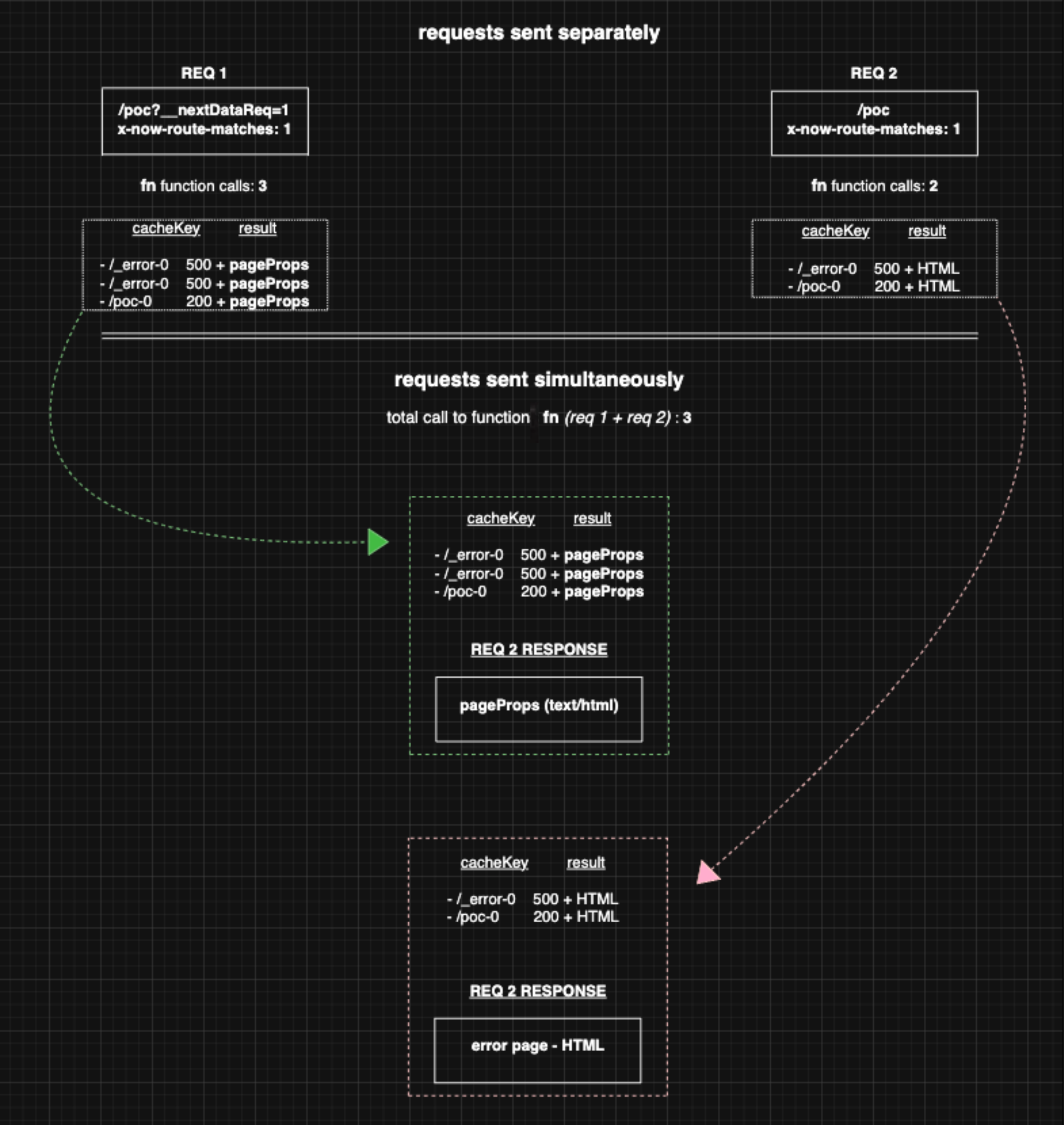
When the calls from request 1 reach the batcher first, this makes it possible to retrieve the result of the fn function initially “hidden” by the body overwrite (caused by the second error as seen previously) and share it with the response of request 2. The latter will display it without issue, since no body overwrite is performed: request 2 doesn’t include the problematic URL parameter that originally caused the (second) error.
It’s worth noting that, since the cacheKey is /_error-0 - and not the path of the originally requested page - the pages called don’t have to be the same. As long as they trigger an error and therefore result in a call with the /_error-0 cacheKey, it’s possible to send multiple requests simultaneously to different paths and still reproduce the race-condition, provided each page throws an error. This works because all the resulting calls share the same cacheKey, meaning the promise won’t be duplicated and the response will be shared across all of them.
Exotic configurations as pillars of exploitation
I was able to get the pageProps back in an altered text/html response, which is nice, but in its current state, it’s not truly exploitable. Two points:
- The
pagePropsdisplayed is that of the error page and therefore does not contain any elements of the request being reflected - The
Cache-Controlis strict:private, no-cache, no-store, max-age=0, must-revalidateso the response is non-cacheable
From there, the exploitability of this attack will depend on the development team’s ability to deploy poor and/or risky configurations.
For the first point, it’s not uncommon to come across applications with enriched pageProps on their error pages, whether for monitoring purposes (like Sentry) or to preserve user preference context.
Among the ways to achieve this, Next.js has an asynchronous method - a legacy API - called getInitialProps, which allows fetching dynamic data before the page is rendered in order to hydrate it. This method can be used in the _app.tsx page (the component within which pages are rendered) to fetch global data or context that should be available across all pages before the initial render.
Although this pattern is officially documented, it is not recommended.
Here is a reproduction of a case encountered on a very large platform, which shared certain properties across all its pages, including static data and a cookie related to user preferences for the application’s theme color:
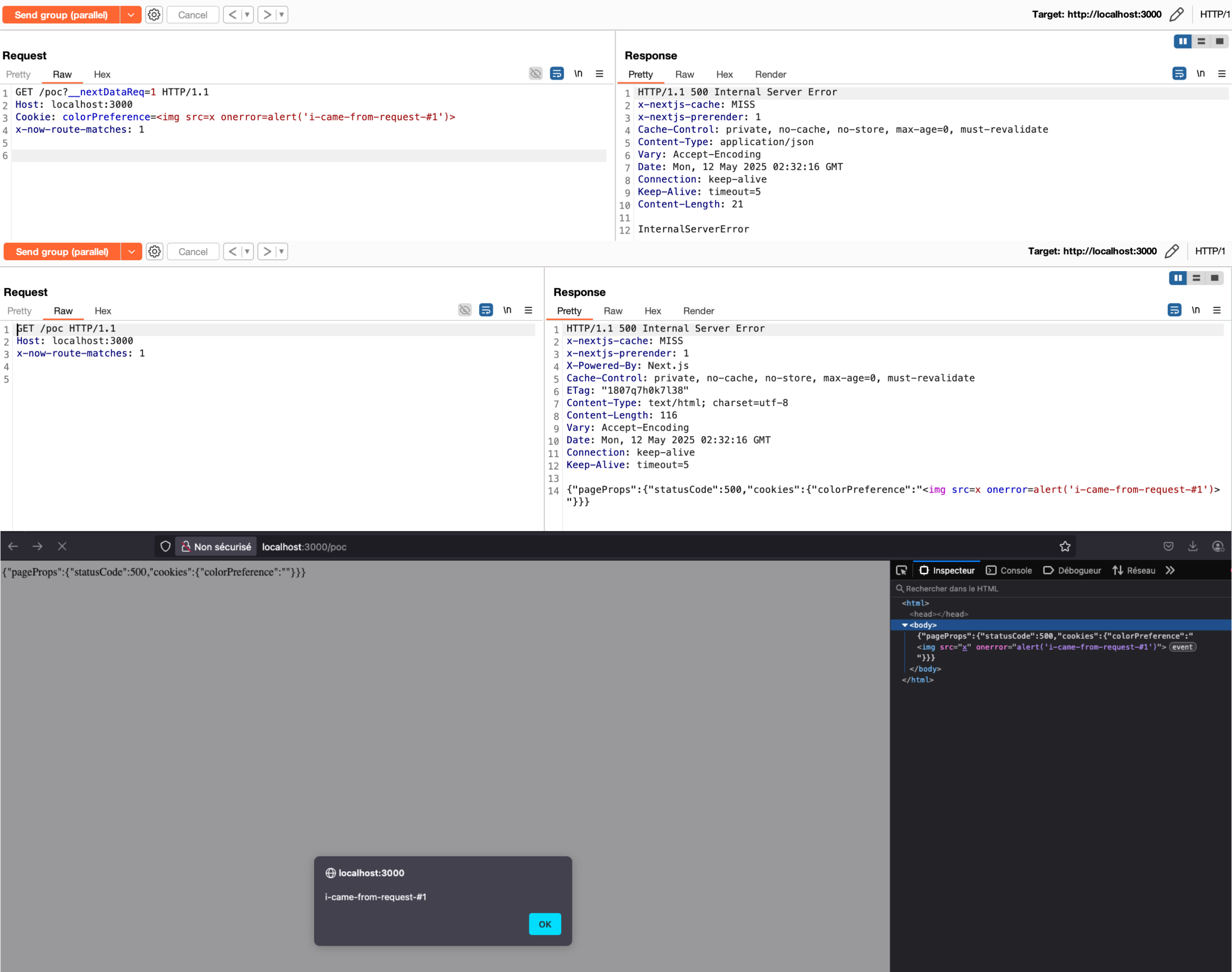 based on a true story
based on a true story
Note that as soon as any element of the request is passed through getServerSideProps (getInitialProps for _app.tsx) - whose original purpose is to provide data that isn’t available at build time, like the cookie here - it becomes a potential attack vector, regardless of its initial use on the client side, since we’re merely rendering the props in a text/html type response.
For the second point, regarding the cache-control restriction, it’s much rarer but I came across some applications that had configured surprising cache rules, which seemed to override the cache-control coming from the origin when it wasn’t a JSON response. I don’t know the reason, and to be honest, I didn’t really look for it, but oddly enough, all of them used Fastly:
 asset of a bug bounty program - race condition to cache-poisoning
asset of a bug bounty program - race condition to cache-poisoning
When these two points are combined, it becomes possible to chain the race-condition with a cache-poisoning attack to ultimately bypass the patch, with the key difference being that the affected caching system is no longer the one provided by the framework.
Although I often used custom (and dirty) scripts for my exploits on real targets, I can’t close this chapter without a shout-out to James Kettle for his exceptional work on the single-packet attack, particularly the Burp functionality that allows sending a group of parallel requests while neutralizing interference from network jitter making execution much simpler.
Bonus - Another way: never-say-never
There is a second way to partially bypass the fix implemented for CVE-2024-46982 that does not include the “race-condition”. When the x-now-route-matches header is added to a request to an SSR endpoint, it is considered SSG, as explained earlier. This causes an HTML page to be generated and placed in the .next/server/pages build directory. This will happen every time an SSR request is sent with the header, and if it’s the same endpoint, the page will simply be overwritten.
If the server is restarted, the first request to the SSR endpoint in question containing x-now-route-matches (normal calls, without the header, are naturally not concerned) will cause the static file to be searched in the .next/server/pages directory. If it exists, it will be retrieved without the cache’s revalidate property being set (not even to 0 as was the case previously). This will allow the execution pipeline to proceed without the error discussed earlier in this paper being thrown:
This is due to the type check, previously, the value was a number - 0 - and the latter being less than 1 the error was triggered, which is not the case when starting the server, the value being undefined consequently bypassing the checks.
The near-impossible, never-say-never scenario is as follows:
- An attacker sends a request to the targeted SSR endpoint containing the
x-now-route-matchesheader + the__nextDataReqURL parameter + injects the payload (if applicable) into the affected request element - Returns to hibernate, hoping something happens (excluding a nextjs update since there’s a rebuild) OR finds a way to bring down the targeted server (maybe there’s a way..?)
- Finally, send a request to the targeted SSR endpoint with only the
x-now-route-matchesheader:
 huss
huss
Notice the differences when the exploit is delivered this way, a 200 response (because no errors), without cache-control, which despite the existing constraints to achieve this state, makes it easier to save this pretty response in some CDN’s that cache responses without cache-freshness indicators. Some examples with Fastly and Cloudflare:
- Fastly :
For example, an HTTP 200 (OK) response with no cache-freshness indicators in the response headers is cacheable and will have a TTL of 2 minutes. (documentation)
- Cloudflare :
By default, Cloudflare caches certain HTTP response codes with the following Edge Cache TTL when a cache-control directive or expires response header are not present (…) documentation
Security Advisory - CVE-2025-32421
Affected versions : <14.2.24, >15.0.0 and <15.1.6
Patched versions : ≥14.2.24 <15.0.0, ≥15.1.6
https://github.com/vercel/next.js/security/advisories/GHSA-qpjv-v59x-3qc4
Vercel changelog : https://vercel.com/changelog/cve-2025-32421
Conclusion
As a result, bypassing the previous CVE is partially possible via two different techniques, sometimes depending on certain factors beyond the control of Next.js, partly due to poor configuration choices. Despite this, the planets align far more often than one might think, and when they do, the damage can be significant, ranging from a simple DoS to stored XSS via (Race-Condition +) Cache-Poisoning. I’ve already identified and reported several vulnerable assets through bug bounty programs, a crucial step in funding these research efforts.
Note: Going forward, only research that leads to findings differing in exploitation methods or outcomes from those already published will be shared on this blog (like this one), regardless of their severity or impact on the ecosystem -except under exceptional circumstances- in order to avoid redundancy.
Thank you for reading.
Al hamduliLlah;
Published in May 2025

